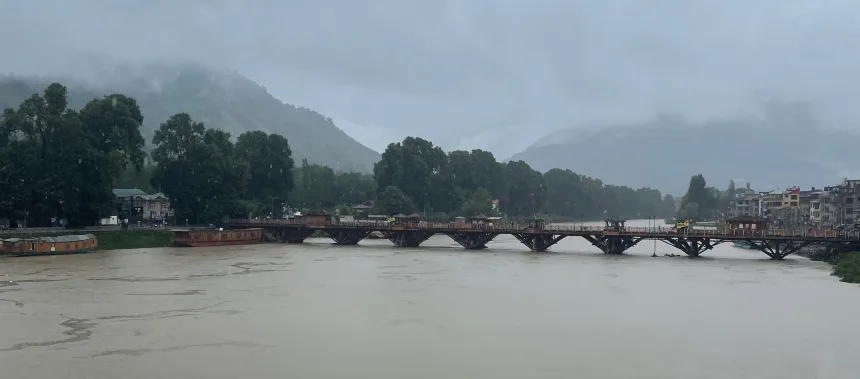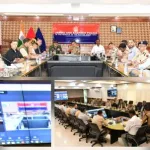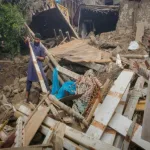Srinagar, Sep 03 : The water bodies in the Kashmir Valley have reached alarming levels following heavy rainfall, with the Jhelum at Sangam and Pampore crossing the danger mark, while Ram Munshi Bagh has entered the warning zone, officials said here.
They said low-lying areas of Srinagar, including Khushipora Telbal, are facing inundation, causing distress among residents, also the old Barzulla Srinagar bridge has been closed for traffic movement.
According to the Irrigation & Flood Control Department (I&FC), the latest readings at River Jhelum, as accessed by the news agency—Kashmir News Observer (KNO), show: Sangam: 26.11 ft (danger mark: 25 ft); Pampore: 5.51 m (danger mark: 5 m); and Ram Munshi Bagh: 18.69 ft (warning mark: 18 ft).
Other readings include Asham: 9.27 ft (danger mark: 16.5 ft) and Wullar: 1576.54 m (full level: 1578 m).
Regarding tributaries, the data show: Vishow Nallah at Khudwani: 11.20 m (danger mark: 8.5 m); Rambiyara Nallah at Wachi: 3.94 m (danger mark: 5.7 m); Lidder Nallah at Batkoot: 1.59 m (danger mark: 1.65 m); and Sindh Nallah at Doderhama: 3.78 m (danger mark: 3.9 m).
Meanwhile, in Khushipora Telbal, eyewitnesses told KNO that water levels in the area are rising, with sudden inundation of houses, lanes and the main road.
Residents rushed to move belongings to higher ground. “Water entered our homes within minutes. We could do little except protect children and elderly members,” said a local.
Some parts of Mehjoor Nagar and Telbal are also waterlogged. Many households reported damage to goods stored on ground floors, while movement in the areas remains severely restricted.
Addationally, the old Barzulla Srinagar bridge has also been closed for traffic movement, as precautionary measures.
I&FC officials said they are closely monitoring the situation and have urged residents to stay away from riverbanks and low-lying areas, while emergency teams remain on standby for any escalation.
Additionally, a joint review meeting on flood preparedness and contingency planning was held at the Police Control Room, Kashmir, to assess readiness in view of prevailing weather conditions and forecasts and to strengthen coordination among all sister agencies working on the ground.
The meeting was attended by Special DGP (Coordination) PHQ J&K, Commandant General HG/CD & SDRF J&K, IGP Kashmir, Divisional Commissioner Kashmir, IGP Traffic, range DIGs, DIGs Armed and IRP, DCs of Kashmir Division, all district SSPs of Kashmir Zone, and senior officers from the Army, CAPFs, and allied departments.
“At the outset, district heads briefed about the evolving flood situation in their respective areas. The Divisional Commissioner shared details of preparedness measures, including embankment protection, rescue and evacuation plans, and contingency arrangements along the river Jhelum and major streams. Alternate communication strategies in case of disruption were also discussed,” said the details.
The participating officers underlined the importance of synergy among departments and stressed the need for a robust disaster mitigation plan to safeguard lives and property.
It was resolved to maintain a high state of readiness, position manpower and machinery at vulnerable points, and ensure real-time dissemination of information to the public and effect prompt evacuation wherever required.
The establishment of Joint Control Rooms with representatives from the civil administration, Police, Army, CAPFs, Flood & Irrigation, and other agencies was deliberated upon.
A detailed review of existing response mechanisms was also conducted, with emphasis on proactive preparedness and stronger inter-agency coordination.
The meeting concluded with a collective resolve to remain alert on the ground and respond promptly to any emerging situation—(KNO)






